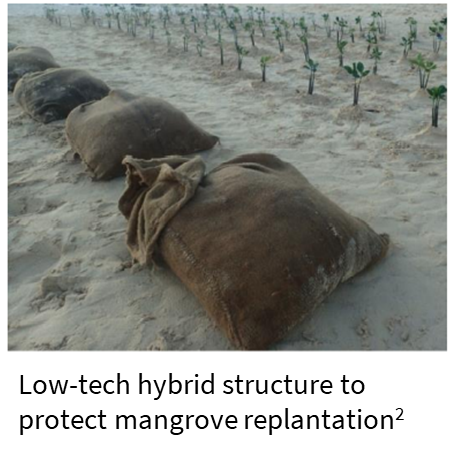Coastal mangrove habitats shape coastal dynamics and can protect shorelines from coastal erosion. Mangroves perform important ecological functions such as sediment trapping, stabilising the seabed and providing habitat for fish, birds and insects. Mangrove forests also benefit local communities by providing resources such as wood and fish and protecting infrastructure from coastal erosion. Restoring mangroves to degraded coastlines can therefore represent an ecosystem-based adaptation option with multiple benefits to local people and the environment.
Mangrove restoration is reforesting the areas where mangroves previously existed. Methods of mangrove restoration are varied and it is important to understand the local context, species and substrates in order to ensure restoration success.
Mangrove restoration commonly includes:
- Collection: Collection of plant propagules (cutting, seed or spore that propagates plants) from sustainable source. Nurseries can also be established to stockpile seedlings for future use.
- Preparation: The restoration site should be prepared for planting. For example, re-establishment of mangroves can assisted by planting vetiver grass (also called dune grass) to provide a stable and protective system for the mangrove root system as the they establish.
- Plantation: Planting of propagules (either directly or after grass has stabilised) at regular intervals at an appropriate time of the year.
- Establishment: The restored area must have minimal human disturbance to allow the mangroves to establish. If the area is subjected to significant wave energy, it may be helpful to construct a low-tech temporary structure to protect from waves.


Mangrove reforestation and coastal habitat conservation implementation is relatively low cost compared to hard infrastructure options. Whilst providing cost estimates is difficult given the broad range of influencing factors across the Pacific, the below table outlines the key components that should be taken into account when estimating a mangrove reforestation project budget for a specific location.
|
|
|
|
|
|
|
|
||||
|
|
|
|||
|
|
|
|||
|
|
|
|||
|
|
|
|||
|
|
|
|||
|
|
|
|||
|
|
||||
|
|
|
|||
|
|
|
The restoration and protection of mangroves and coastal habitats represents an ecosystem-focused adaptation approach which supports diverse and dynamic marine environments which deliver multiple benefits for local communities. In contrast, denuded and exposed coastlines offer reduced supporting and provisional ecosystem services. These functions can only partially be delivered through engineering approaches (such as the installation of sea walls to reduce coastal erosion risk) and many engineering approaches can create additional environmental and social impacts.
- -
Mangrove Restoration - Costs and Benefits of Successful Ecological Restoration. See https://www.fao.org/forestry/10560-0fe87b898806287615fceb95a76f613cf.pdf
- -
Technologies for Climate Change Adaptation – Coastal Erosion and Flooding. See https://www.researchgate.net/publication/216584246_Technologies_for_Climate_Change_Adaptation_-_Coastal_Erosion_and_Flooding
- -
Pacific Mangrove Initiatives. See https://www.mangrovealliance.org/pacific-mangroves-initiative/
- -
Pacific Island Mangroves in a Changing Climate and Rising Sea. See https://wedocs.unep.org/bitstream/handle/20.500.11822/11812/rsrs179.pdf?sequence=1&isAllowed=y
- -
1,2. Mangrove Planting Guidelines for Kiribati. See https://www.sprep.org/sites/default/files/documents/publications/mangrove-planting-guidelines-Kiribati.pdf
Case study
Mangrove planting guidelines
Understanding the benefits of mangrove reforestation is one thing but understanding how to achieve successful mangrove reforestation takes time, energy and knowledge. The Mangrove Planting Guidelines for Kiribati, provide a step-by-step guide to the challenge of mangrove planting. While the details in the guidelines are specific to Kiribati and focus on methods that work most effectively in Kiribati settings, the guidelines have wider application throughout the Pacific and include a review of reasons why some mangrove reforestation efforts are not successful. The guidelines also cover monitoring and evaluation of mangrove restoration efforts, which can be applied in any setting.
Resource: Mangrove Planting Guidelines for Kiribati, https://www.sprep.org/sites/default/files/documents/publications/mangrove-planting-guidelines-Kiribati.pdf
